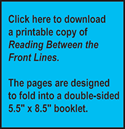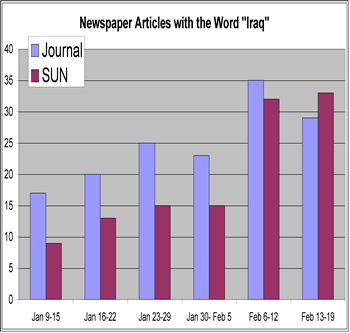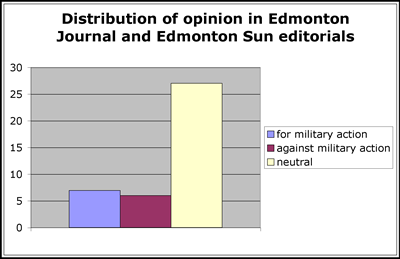Analysis of Source
Articles
by Bequie Lake
There were a few times, in the lead-up to the
recent war against Iraq, that I curled up with a local paper, to “get
informed” and instead began to wonder if I was reading copy
straight from a press release from the office of Donald Rumsfeld.
Local media wasn't quite the unabashed cheerleading of CNN, but it
didn't feel exactly, um... “balanced” either.
And I wasn't the only one with this problem. It's pretty universally
acknowledged that the media plays a big role in creating public support
for international conflicts – whether it’s called “wartime
propaganda” or “manufacturing consent.” According
to some, the media spreads patriotism and aggression like a disease.
So starting in December 2002, the Media Working Group – a project
of the Alberta Public Interest Research Group (AP!RG), a campus-based
umbrella for social justice and environmental projects – tried
to pin down some of the tendencies that make war coverage in our local
media sources so suspect.
Over a six week period from January 9th to February 19th, 2003 the
AP!RG Media Working Group analyzed coverage of Iraq from the Edmonton
Journal, the Edmonton Sun, Vue Weekly and See Magazine. We looked
at three things: the sources used, the language used and the overall
bias.
During the period of the study, readers were bombarded with coverage
of the build-up to war in Iraq. A total of 269 Iraq-related articles
were collected from the four newspapers. The dailies, the Journal
and the Sun, together published 266 of those articles, and the weeklies,
Vue and See, published 3. That’s an average of 3.5 articles
per day in the Journal, and 2.8 in the Sun (and, well, not quite as
many in Vue and See).
None of the papers sent reporters directly to Iraq during the study
period. So all of their coverage of the looming war on Iraq depended
on other news providers, including newswires such as the Associated
Press and Canadian Press, conglomerates like Sun Media and Southam,
and other newspapers, like The New York Times and the Washington Post.
On average, the Sun took most of its coverage from the Associated
Press (61%), and the remainder from Canadian Press (27%) from Sun
Media (13%). The Journal, on the other hand, was more varied: 19%
from AP, 10% from CP, 9% from CanWest, 21% from Southam, 10% from
the New York Times, 9% from the Washington Post, 7% from the LA Times,
and 16% from other sources including, Christian Science, the Calgary
Herald and Newsday. (Numbers do not add up to 100% due to rounding).
(Vue and See tend to either focus on local stories, or pen articles
based on unnamed sources.) These figures show us again something we
already know – most of our news comes from a few agenda-setting
corporations which own a lot of media. And a lot of them are American.
So how did the large percentage of American ownership affect the coverage
of the war in our study period? Well, to start, the largest source
of citations both direct and indirect, were from the American government
and military, with almost half (47%) of all stories citing American
officials. Iraq trailed the US, with only a fifth (21%) of stories
citing Iraqi government sources. (And these numbers do not even reflect
the actual disparity between these two sources.
Often, American sources dominated entire articles, where Iraqi sources
had a single quote at the end – for balance, we assume).
We also looked at how the papers used language – using four
keywords, “terror,” “peace,” “security”
and “weapons.” The use of the word “terror,”
for instance, demonstrates a clear bias in the media portrayal of
Iraq.
In all 267 articles, there were 72 references to “terror,”
“terrorism” and “terrorist(s).” Almost a quarter
of these references referred directly to links between Iraq and “terror”.
In contrast, only one article makes a link between “terrorism”
with the United States, despite the fact that there are stronger and
better documented links between Al-Qaeda and the United States (see
Jonathan and Gwynne Beaty’s The Outlaw Bank, or J.H. Hatfield
and Mark Crispin Miller’s Fortunate Son). As the American government
tried desperately to link the Iraqi state with terrorists, the media
played right into their hands.
An even more dramatic example is that out of 524 references to “weapons,”
297 (57%) referred to Iraqi “weapons,” compared with 2
references (0.4%) to “weapons” possessed by the United
States.
There are almost 150 times as many references to Iraqi weapons as
American weapons. And considering the fact that, the US spends 400
times as much on military “defense” as Iraq (400 billion
vs. about 1 billion), Iraqi weapons gets lot of mileage in print.
In fact, per dollar spent on “defense” Iraq got 60,000
times as many references to weapons as the United States.
This is not to say that American weapons are not highly sung in the
media – they are. But reporters use different words like “arms,”
“technology,” or the name of the weapon, rather than the
more dangerous sounding “weapons.” And in one of the two
occurrences where American weapons were called weapons, the reporter
qualified the statement, by explaining that they are “precision-guided”
(Edmonton Journal, “UN Chief Weapons inspectors want to carry
on work in Iraq into March” Jan 14). (The other occurrence is
on a sign held at a German protest, translated in the caption as “Weapons
inspectors into the USA” (Edmonton Journal, “Europe smoothes
over divisions”, Feb. 18)).
To be fair, many of the references to Iraqi “weapons”
in the newspaper aren't reported as fact: about a quarter of them
qualify their accusations with words like “widely suspected”
or “claims.”
Sometimes the accusations are even outright
refuted, as in quotations from then Iraqi Foreign Minister, Naji Sabri,
saying “there are no banned weapons in Iraq” (Edmonton
Journal, “We’re set for war, say Iraqi marchers”,
Feb. 16). But its uncertain whether these disclaimers have any effect
– it all seems a bit like that scene from Wag the Dog, where
Robert Deniro’s character masterminds a blitz of media-speculation
by hosting a press conference to explain that “there is no b-3
bomber.” “There are no Iraqi weapons,” the paper
quotes, but they also entertain a host of speculations, from the mundane
to the totally bizarre.
This dichotomy between the “dangerous” Iraqis and the
“precision-guided” Americans was propped up by other reporting
biases. Articles humanize Canadian and American soldiers, describing
how Canadians “are training in the numbing cold of the Canadian
winter” (EJ, “Troops train in snow, but in Iraq it’ll
be hot” Jan. 31), and how American soldiers are banking sperm
“in case an attack renders them infertile” (EJ, “Chemical
warfare has soldiers banking sperm”, Jan. 31). Aw, poor little
dudes. (The soldiers, I mean. Not the sperm.)
Iraqi citizens get no such treatment. A February 16 article describes
a protest where “tens of thousands of people marched in cities
across Iraq, many brandishing assault rifles and waving giant pictures
of Saddam” (EJ, “We’re set for war, say Iraqi marchers”).
These dangerous sounding images of Iraqi citizens are backed up with
a few overtly ethnocentric and racist editorial comments about Arabs
and Muslims, like the Sun’s Eric Margolis describing the Arab
world’s “chronic disunity, backstabbing and petty tribalism”
(Feb. 2), the Journal’s Lorne Gunter implying that the Koran
is hate literature (Feb. 12), or the New York Times’ Thomas
L. Friedman suggesting that young, radical Muslims are the “real
weapons of mass destruction” (EJ, Feb. 20).
Geez, it’s a good thing the States went to war, huh? Otherwise
those weapon-laden, rifle brandishing Muslims would probably have
come over and got us (while we trained doggedly in the cold).
I’m not trying to be a conspiracy theorist – after all
the Edmonton Journal is hardly the tail that wags the dog. And we
do have some alternative papers, which occasionally present an alternative
viewpoint. But all in all, the persistent bias in coverage of Iraq
seems to reflect some kind of brain damage – hopefully it isn’t
catching.
Back to top







